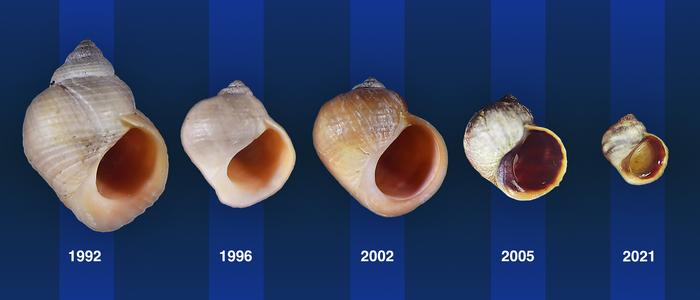In 1988, the Koster archipelago off Sweden’s west coast faced a severe bloom of toxic algae that devastated the local marine snail populations. While it might seem insignificant to worry about a few snails on a small rock in the ocean, this event provided a rare chance to witness evolution in real time.
Previously, the islands were home to thriving and diverse populations of the marine snail species Littorina saxatilis. Although the snail populations on larger islands rebounded within two to four years, several rocky skerries struggled to recover from the catastrophe.
Kerstin Johannesson, a marine ecologist from the University of Gothenburg, saw a unique opportunity. In 1992, she reintroduced L. saxatilis snails to the skerries, setting off a long-term experiment with significant implications that researchers from the Institute of Science and Technology Austria (ISTA), Nord University, Norway, the University of Gothenburg, Sweden, and The University of Sheffield, UK, would later join to observe the unfolding of evolution.
The Snails: Wave and Crab Ecotypes
L. saxatilis, a common marine snail species found along North Atlantic shores, has developed traits suited to its environment. These traits vary notably between two ecotypes: the Crab-ecotype and the Wave-ecotype. Crab snails have evolved in predator-dominated environments and tend to be larger, with thicker shells and warier behavior. Conversely, Wave snails thrive in more exposed areas and are generally smaller with thinner, patterned shells and bolder behaviors.
Before the algae bloom, Wave snails inhabited the skerries, while Crab snails populated the nearby shores. This geographical proximity would later play a critical role in the study.
Rediscovering Lost Traits
With the Wave snail population of the skerries completely eradicated, Johannesson decided to reintroduce Crab snails to one of these habitats in 1992. She anticipated that the Crab snails would adapt to their new surroundings quickly, benefiting from their ability to reproduce one to two generations annually. “Our colleagues noticed signs of adaptation within the first decade of the experiment,” recalls Diego Garcia Castillo, a graduate student at ISTA and one of the study’s lead authors. “Over 30 years, we could accurately predict the snails’ appearance and the genetic regions involved. The transformation was both rapid and profound.”
Importantly, the snails did not evolve these new traits from scratch. Co-corresponding author Anja Marie Westram, a former postdoc at ISTA now at Nord University, explains that some genetic diversity was already present in the original Crab population but at low frequencies due to past environmental conditions. Access to a broad gene pool facilitated this swift evolutionary process.
Diversity Fuels Adaptation
The research team investigated three primary aspects throughout the experiment: the snails’ physical characteristics, individual genetic variabilities, and larger chromosomal changes known as “chromosomal inversions.”
In the initial generations, the scientists observed “phenotypic plasticity,” where the snails quickly altered their shapes to better fit their new environment. However, genetic changes also rapidly ensued. The researchers could foresee the magnitude and direction of these genetic shifts, particularly regarding chromosomal inversions. Their findings indicated that the snails’ swift and significant transformation resulted from two complementary processes: rapid selection of pre-existing traits in the transplanted Crab snail population and gene flow from neighboring Wave snails that may have drifted over 160 meters to the skerry.
Adapting to Modern Challenges
Theoretically, scientists understand that species with sufficient genetic diversity can adapt more quickly to environmental changes. However, few studies have attempted to track evolution in real time in the wild. “This research enables us to closely examine repeated evolution and predict how a population may develop traits that have previously evolved under similar conditions,” says Garcia Castillo.
The team aims to explore how species can adapt to contemporary environmental challenges, including pollution and climate change. “Not all species have access to extensive gene pools, and evolving new traits from scratch can be painfully slow. Adaptation is complex, especially in a world facing extreme weather, rapid climate changes, pollution, and new parasites,” Westram points out. She hopes this work will inspire further research into preserving species with diverse genetic foundations. “Perhaps this study can encourage conservation efforts to protect various natural habitats, preventing species from losing their genetic variation,” she concludes.
Today, the snails Johannesson reintroduced to the skerry in 1992 have flourished, boasting a population of approximately 1,000 individuals.
